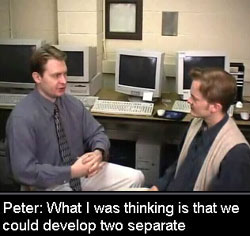Digital video information typically includes audio, which, again, needs to be transcribed. However, because it is video, there is a capability to provide the text transcript synchronously with the corresponding dialogue (and all relevant audio information) as it happens. This is called captioning, and it comes in two forms: open and closed.
Closed captions are the captions that can be turned on and off, using the television's remote control.
Open captions are the captions that are permanently turned on, similar to foreign language subtitles.


There is an important distinction between captions and subtitles: subtitles provide a translation of dialogue only, while captions are always in the native language being spoken and provide a textual indication of all significant audio information, including sound effects and music.
For accessibility concerns, subtitles are not equivalent to captions because subtitles do not convey all of the significant audio information of the video. Consider the potential for losing valuable content details in the following examples of sound that would not be included in subtitles:
To create accessible video, ensure that captioning is in place. Also, ensure that the media playback application is accessible, allowing the end user to control the playback of the content.
Depending on the digital video file format, the production tools available, and the level of technical skills and abilities of the technician, the options for creating captions will vary. Ultimately, with proper planning, training, and resources, it is possible to caption digital video for use as instructional materials in Web-based instruction.
As of this writing, there is a small pool of digital video file formats commonly in use that allow for captioning. To ensure accessibility of video information, always use a video format that supports captioning. The following video formats currently support captioning: QuickTime Movie (.mov), MPEG (.mpg or .mpeg), AVI (.avi), Flash Video (.flv or .swf), Windows Media (.wmv or .asx) and Real Player Media (.rpm). Always ensure that captioning is in place. Audio description may prove to be a viable solution and should be considered as an addition to video content.

8800 Grossmont College Drive
El Cajon, California 92020
619-644-7000
Accessibility
Social Media Accounts